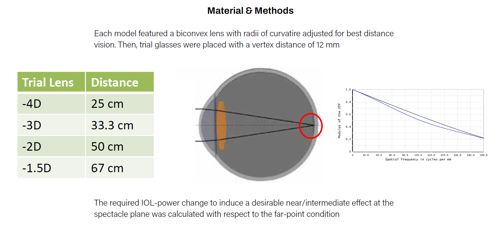Cataract
Rethinking ACD and Near Add
Deeper anterior chambers may need more add power in multifocal IOLs.

Howard Larkin
Published: Monday, October 2, 2023
Anterior chamber depth (ACD) correlates highly with variations in the add power required to provide patients with an acceptable reading vision distance with multifocal intraocular lenses (IOLs) that fully correct for distance vision. As a result, patients with deeper ACDs may need a higher add power, while those with shallower ACDs may find their reading distance shorter than planned preoperatively, according to Dr Grzegorz Łabuz.
He noted this effect may also partially explain why defocus curves reported in clinical studies vary significantly in patients implanted with the same model of multifocal lenses.
“Although each multifocal lens type has its unique and fixed addition, the position of the secondary visual acuity peak detected in defocus measurements may show high intersubject variability,” he said, adding more research is needed to establish this connection.
Model eyes tested
The ACD, in part, determines the effective lens position after surgery, Dr Łabuz explained. The differences in lens power add needed to achieve a +2.00 D add at the IOL plane varied as much as 0.52 D in a study he conducted on 34 patients scheduled for routine cataract surgery. Variation was more for higher adds and less for lower adds.
The study was designed to predict the add-power shift due to ocular biometry differences in pseudophakic eyes using raytracing simulations in model eyes created for each patient. Each model featured a biconvex lens with radii of curvature adjusted for best distance vision. Then, the team placed trial glasses with a vertex distance of 12 mm. They calculated the required IOL power change to induce a desirable near-to-intermediate effect relative to the distance power.
“There is a nearly linear relationship between the ACD and the add power demand,” Dr Łabuz reported. The R2 value was 0.96, he said. By contrast, axial length differences show only a low correlation with add power required to achieve a desired reading distance—an R2 value of 0.096—while keratometry differences show no correlation at all.
“When you implant a multifocal lens in a patient with shallower ACD [as in many hyperopes], a lower add power may be required to prevent their reading distance from being too close to the eye,” Dr Łabuz said. “In contrast, a higher power add may be needed in patients with deeper anterior chambers. For instance, in myopes, who are often used to reading at closer distances.”
Dr Łabuz presented his study at the 2023 ASCRS annual meeting in San Diego, US.
Grzegorz Łabuz PhD is senior optical scientist at the David J Apple Center for Vision Research and research fellow at Heidelberg University Hospital, Heidelberg, Germany. grzegorz.labuz@med.uni-heidelberg.de

Latest Articles
Towards a Unified IOL Classification
The new IOL functional classification needs a strong and unified effort from surgeons, societies, and industry.
The 5 Ws of Post-Presbyopic IOL Enhancement
Fine-tuning refractive outcomes to meet patient expectations.
AI Shows Promise for Meibography Grading
Study demonstrates accuracy in detecting abnormalities and subtle changes in meibomian glands.
Are There Differences Between Male and Female Eyes?
TOGA Session panel underlined the need for more studies on gender differences.
Simulating Laser Vision Correction Outcomes
Individualised planning models could reduce ectasia risk and improve outcomes.
Need to Know: Aberrations, Aberrometry, and Aberropia
Understanding the nomenclature and techniques.
When Is It Time to Remove a Phakic IOL?
Close monitoring of endothelial cell loss in phakic IOL patients and timely explantation may avoid surgical complications.
Delivering Uncompromising Cataract Care
Expert panel considers tips and tricks for cataracts and compromised corneas.
Organising for Success
Professional and personal goals drive practice ownership and operational choices.